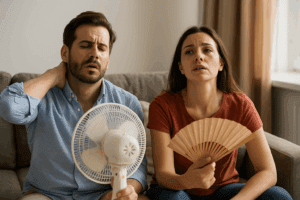
Why Is My HVAC System Not Cooling? 10 Common Causes Explained
If you’ve ever walked into your home on a hot Florida afternoon expecting cool relief—only to find warm, stagnant air—you know how frustrating HVAC problems can be. I’ve had hundreds of homeowners call me in a panic asking the same question: “Why isn’t my air conditioner cooling?”
My name is Allen Chambers. I’m a master electrician and licensed HVAC contractor with over 20 years of experience helping Florida homeowners design, maintain, and troubleshoot high-performance HVAC systems. When your system stops cooling properly, it’s usually one of a handful of issues. The key is figuring out which one—and getting it fixed fast before you’re stuck sweating through another hot night.
Let’s walk through the 10 most common reasons your HVAC system may not be cooling and what you can do about each one.
1. Dirty or Clogged Air Filters
This is by far the most common issue I see in Florida homes. When your air filters get clogged with dust, pet hair, and debris, airflow becomes restricted. That restricted airflow makes it harder for your system to circulate cool air, and in severe cases, it can cause the evaporator coil to freeze up entirely.
Replacing your filters every one to three months—especially during heavy usage seasons—is one of the simplest ways to prevent cooling issues.
2. Low Refrigerant Levels
Refrigerant is what allows your system to absorb and move heat out of your home. If your system is low on refrigerant, either from a leak or improper charge, it simply can’t cool the air effectively.
Low refrigerant often leads to warm air blowing from the vents, ice buildup on refrigerant lines, and longer-than-usual cooling cycles. This is not something you can safely fix yourself—it requires a licensed technician to locate leaks, repair them, and recharge the system.
3. Dirty Condenser Coils
Your condenser coils sit outside and are exposed to dirt, leaves, and debris year-round. When these coils get coated with grime, your system struggles to release heat into the outside air, reducing its overall cooling efficiency.
I recommend having your condenser cleaned during your annual HVAC maintenance. In Florida’s humid, pollen-heavy climate, some homeowners need coil cleanings more often to maintain peak performance.
4. Faulty Thermostat
Sometimes the problem isn’t with your air conditioner at all—it’s with your thermostat. A malfunctioning thermostat can misread temperatures, fail to trigger the cooling cycle, or cycle inconsistently.
Before assuming the worst, check that your thermostat has working batteries, is set to “cool,” and is reading the correct indoor temperature. If it’s still acting up, you may need to replace the thermostat or have it recalibrated.
5. Electrical Issues or Tripped Breakers
Your HVAC system relies on multiple electrical components to function. If a breaker trips, fuse blows, or a control board malfunctions, your system may run partially—or not at all.
I’ve seen plenty of cases where the blower fan runs but the outdoor condenser unit won’t turn on, leading to warm air from the vents. When this happens, call a professional immediately to safely diagnose electrical failures.
6. Frozen Evaporator Coil
When airflow is restricted (often due to dirty filters or blocked ducts), your evaporator coil can freeze up. Once frozen, it cannot properly absorb heat from the air, leaving you with lukewarm airflow or none at all.
If you notice ice buildup on your indoor unit or refrigerant lines, shut off the system immediately to let it thaw and call a technician. Running the system while frozen can cause serious long-term damage.
7. Leaky or Disconnected Ductwork
Duct issues can also be behind your cooling problems. If cooled air is escaping through cracks, loose joints, or disconnected ducts in your attic or crawl space, your system has to work harder to maintain the desired temperature.
Even small leaks can significantly reduce cooling efficiency, drive up your energy bills, and create uneven cooling throughout your home.
8. Blocked or Closed Vents
Sometimes, the solution is surprisingly simple. Closed or obstructed vents restrict airflow to certain rooms, causing hot and cold spots throughout your house.
Walk through your home and ensure all supply and return vents are open and unblocked by furniture, curtains, or rugs. This keeps air circulating evenly throughout your living space.
9. Compressor Failure
The compressor is essentially the heart of your air conditioning system. When it fails, your system can’t circulate refrigerant, and cooling stops entirely.
Compressor replacement is one of the most expensive HVAC repairs, often making full system replacement more economical if your unit is nearing the end of its lifespan.
10. Your System Is Simply Old
Finally, sometimes your system just can’t keep up anymore. Most HVAC units last 10 to 15 years in Florida’s harsh climate, depending on how well they’ve been maintained.
If your system is aging and you’re dealing with frequent repairs, declining efficiency, and uneven cooling, it may be time to consider a full replacement with a high-efficiency system that can better handle Florida’s long cooling seasons.

How Much Does It Cost to Repair These Common Cooling Problems?
When your HVAC system stops cooling, one of the first questions that comes to mind is, “How much is this going to cost me?” The truth is, repair costs vary widely depending on the issue, the age of your system, and how quickly you catch the problem.
Based on what I see every day in Florida, here’s a breakdown of what you can expect to pay for the most common cooling repairs:
Air Filter Replacement
This is the most affordable fix. Standard filters cost $10 to $30 each, and you can typically handle this yourself. Specialty filters or whole-home filtration systems may cost a bit more but are still inexpensive compared to full repairs.
Refrigerant Recharge and Leak Repair
If your system is low on refrigerant due to a small leak, you’ll likely pay $200 to $600 for a recharge, depending on how much refrigerant is needed. If a leak needs to be located and repaired, expect $500 to $1,500, especially if it’s a hard-to-access location.
Condenser Coil Cleaning
Basic outdoor coil cleaning during maintenance runs about $75 to $150. If the coils are heavily clogged and require deep cleaning or disassembly, it could cost closer to $300.
Thermostat Replacement
If your thermostat is faulty, a basic replacement may cost $150 to $300 installed. Upgrading to a smart thermostat will run $400 to $600 depending on the model and installation requirements.
Electrical Repairs
Fixing electrical issues such as capacitor replacements, faulty relays, or minor wiring problems generally costs $150 to $450, depending on which part fails.
Frozen Evaporator Coil
If your evaporator coil freezes due to airflow problems, you may only need to pay for diagnosis and coil thawing, around $150 to $300. If ongoing issues damage the coil, full coil replacement can run $1,000 to $2,000.
Duct Repair
Sealing or reconnecting loose ducts costs around $300 to $700, while extensive duct replacement may cost $1,500 to $4,000 for larger homes.
Compressor Replacement
This is one of the most expensive repairs you can face. Replacing a failed compressor typically costs $1,500 to $3,000. If your system is older, this is often the point where full system replacement becomes more cost-effective.

When Does It Make Sense to Replace Instead of Repair?
As a rule of thumb, I tell homeowners that if the repair bill exceeds 50% of the cost of a new system, and your unit is more than 10 years old, replacement becomes the smarter long-term investment.
High-efficiency systems today are far more energy-efficient and can save you thousands in operating costs over their lifespan. And in Florida’s long cooling season, those savings add up quickly.
Don’t Wait for a Total Breakdown
In most cases, cooling issues start small and get progressively worse if left untreated. The sooner you address minor problems like airflow restrictions or refrigerant leaks, the more likely you are to avoid costly breakdowns during peak summer months.
Routine maintenance is the single best way to catch these issues early. I always recommend homeowners schedule two professional HVAC checkups per year—once in spring before cooling season starts, and once in fall before you switch to heating.
If your system isn’t cooling like it should and you’re not sure where to start, give your trusted HVAC contractor a call. After 20 years in this business, I can confidently say that early diagnosis saves homeowners thousands in the long run.
—
About the Author
I’m Allen Chambers, a master electrician and licensed HVAC contractor with over 20 years of experience helping Florida homeowners design energy-efficient, high-performance HVAC solutions. As a contributor to HVAC Service Cost, I focus on making heating and cooling upgrades more affordable, sustainable, and stress-free for families across the state.




Leave a Reply